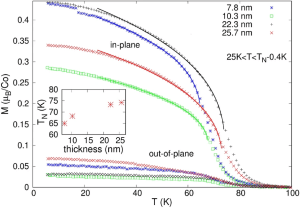
In bulk form, LaCoO3 is not magnetic. In thin film form, this compound can become magnetic. Although magnetism has traditionally been attributed to a thermally-induced intermediate state or to oxygen vacancy defects, we find that strain causes antiferromagnetic interactions at high temperatures, and a weak ferromagnetism at low temperatures. The different magnetic behaviors of LaCoO3 films grown on LaAlO3 and SrTiO3 are related to the Co-O-Co bond angles and the constraints imposed on the Co-O bond lengths by the substrate geometries. Long-range magnetic order occurs below T ~ 90 K when the Co-O-Co bond angle is greater than 163 degrees, consistent with the behavior of bulk and nanoparticles forms of LaCoO3. A LaAlO3 substrate prevents magnetic long-range order at low temperatures near the film-substrate interface and collinear antiferromagnetic sublattices away from the interface. At low temperatures, the antiferromagnetically ordered sublattices are non-collinear in films grown on SrTiO3 substrates, leading to a significant net moment. Films gown on LaAlO3 with a SrTiO3 strained buffer layer at the interface are not magnetic, showing that a purely chemical interaction with the SrTiO3 is not responsible for the observed phenomena.
This article was published in Journal of Materials Research and is available here.
